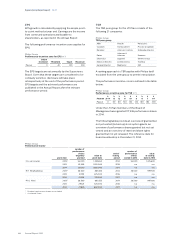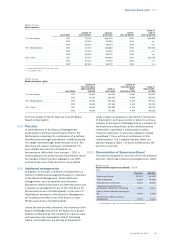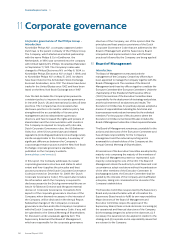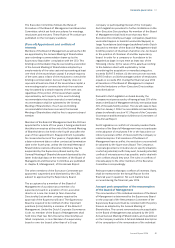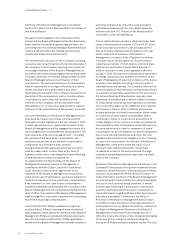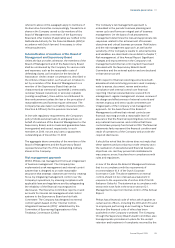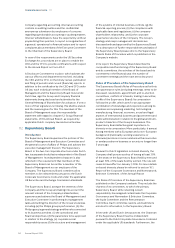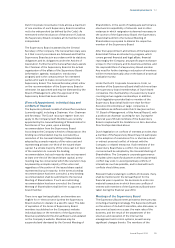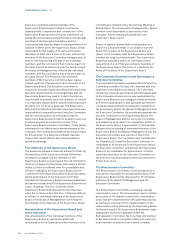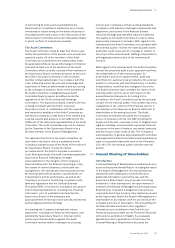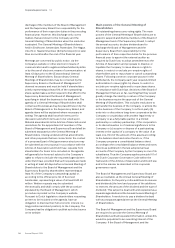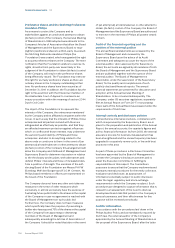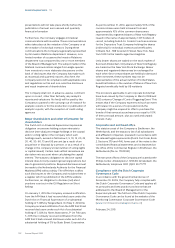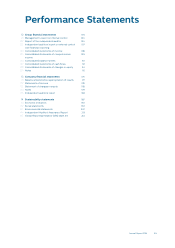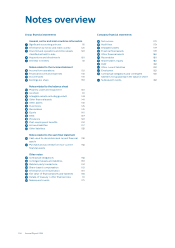Philips 2014 Annual Report Download - page 95
Download and view the complete annual report
Please find page 95 of the 2014 Philips annual report below. You can navigate through the pages in the report by either clicking on the pages listed below, or by using the keyword search tool below to find specific information within the annual report.Corporate governance 11.2
Annual Report 2014 95
Dutch Corporate Governance Code allows a maximum
of one member of each Supervisory Board committee
not to be independent (as defined by the Code). As
mentioned in the introduction of this section 11.2 above,
the Supervisory Board considers all its members to be
independent.
The Supervisory Board is assisted by the General
Secretary of the Company. The General Secretary sees
to it that correct procedures are followed and that the
Supervisory Board acts in accordance with its statutory
obligations and its obligations under the Articles of
Association. Furthermore the General Secretary assists
the Chairman of the Supervisory Board in the actual
organization of the aairs of the Supervisory Board
(information, agenda, evaluation, introductory
program) and is the contact person for interested
parties who want to make concerns known to the
Supervisory Board. The General Secretary shall, either
on the recommendation of the Supervisory Board or
otherwise, be appointed and may be dismissed by the
Board of Management, after the approval of the
Supervisory Board has been obtained.
(Term of) Appointment, individual data and
conicts of interests
The Supervisory Board consists of at least five members
(currently eight), including a Chairman, Vice-Chairman
and Secretary. The Dutch ‘structure regime’ does not
apply to the Company itself. Members are currently
appointed by the General Meeting of Shareholders for
fixed terms of four years, upon a binding
recommendation from the Supervisory Board.
According to the Company’s Articles of Association, this
binding recommendation may be overruled by a
resolution of the General Meeting of Shareholders
adopted by a simple majority of the votes cast and
representing at least one-third of the issued share
capital. If a simple majority of the votes cast is in favor
of the resolution to overrule the binding
recommendation, but such majority does not represent
at least one-third of the issued share capital, a new
meeting may be convened at which the resolution may
be passed by a simple majority of the votes cast,
regardless of the portion of the issued share capital
represented by such majority. In the event a binding
recommendation has been overruled, a new binding
recommendation shall be submitted to the General
Meeting of Shareholders. If such second binding
recommendation has been overruled, the General
Meeting of Shareholders shall be free to appoint a
board member.
There is no age limit applicable, and members are
eligible for re-election twice (unless the Supervisory
Board resolves to deviate in a specic case). The date
of expiration of the terms of Supervisory Board
members is published on the Company’s website.
Individual data on the members of the Supervisory
Board are published in the Annual Report, and updated
on the Company’s website. Members may be
suspended and dismissed by the General Meeting of
Shareholders. In the event of inadequate performance,
structural incompatibility of interests, and in other
instances in which resignation is deemed necessary in
the opinion of the Supervisory Board, the Supervisory
Board shall submit to the General Meeting of
Shareholders a proposal to dismiss the respective
member of the Supervisory Board.
After their appointment, all members of the Supervisory
Board shall follow an introductory program, which
covers general financial and legal aairs, financial
reporting by the Company, any specific aspects that are
unique to the Company and its business activities, and
the responsibilities of a Supervisory Board member.
Any need for further training or education of members
will be reviewed annually, also on the basis of an annual
evaluation survey.
Under the Dutch Corporate Governance Code, no
member of the Supervisory Board shall hold more than
five supervisory board memberships of Dutch listed
companies, the chairmanship of a supervisory board
counting as two regular memberships. In addition,
Dutch legislation provides that no member of the
Supervisory Board shall hold more than five Non-
Executive Directorships at ‘large’ companies or
foundations as defined under Dutch law (see section
11.1, Board of Management, of this Annual Report), with
a position as chairman counting for two. During the
financial year 2014 all members of the Supervisory
Board complied with the limitations on Non-Executive
Directorships described above.
Dutch legislation on conflicts of interests provides that
a member of the Supervisory Board may not participate
in the adoption of resolutions if he or she has a direct
or indirect personal conflict of interest with the
Company or related enterprise. If all members of the
Supervisory Board have a conflict, the resolution
concerned will be adopted by the General Meeting of
Shareholders. The Company’s corporate governance
includes rules to specify situations in which a (potential)
conflict may exist, to avoid (potential) conflicts of
interests as much as possible, and to deal with such
conflicts should they arise.
Relevant matters relating to conflicts of interests, if any,
shall be mentioned in the Annual Report for the
financial year in question. No decisions to enter into
material transactions in which there are conflicts of
interest with members of the Supervisory Board were
taken during the financial year 2014.
Meetings of the Supervisory Board
The Supervisory Board meets at least six times per year,
including a meeting on strategy. The Supervisory Board,
on the advice of its Audit Committee, also discusses, in
any event at least once a year, the main risks of the
business, and the result of the assessment of the
structure and operation of the internal risk
management and control systems, as well as any
significant changes thereto. The members of the



